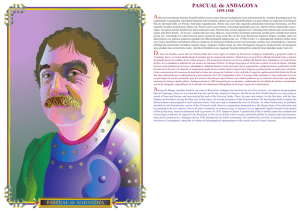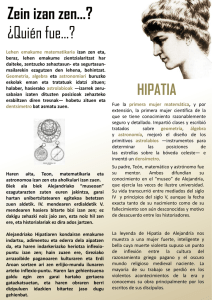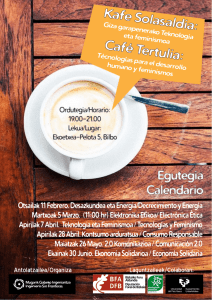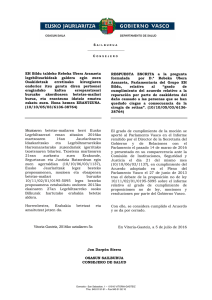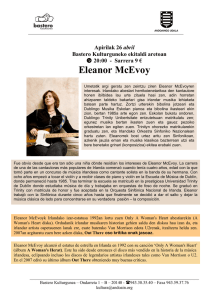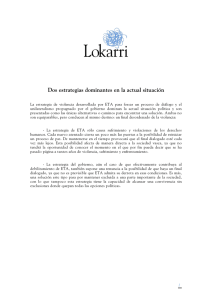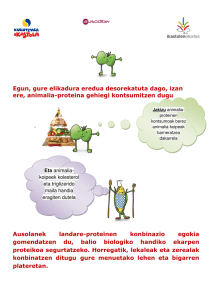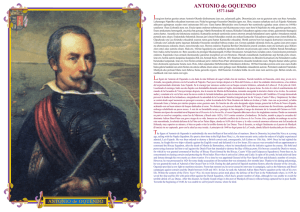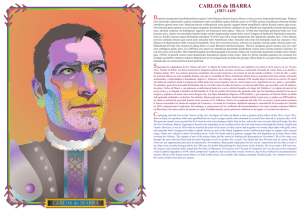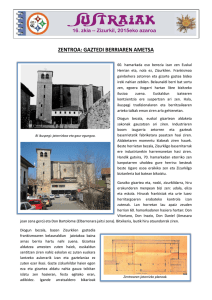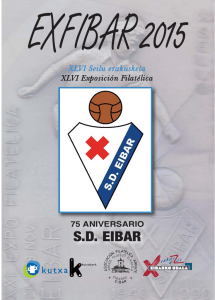IGNACIO MARÍA de ALAVA
Anuncio
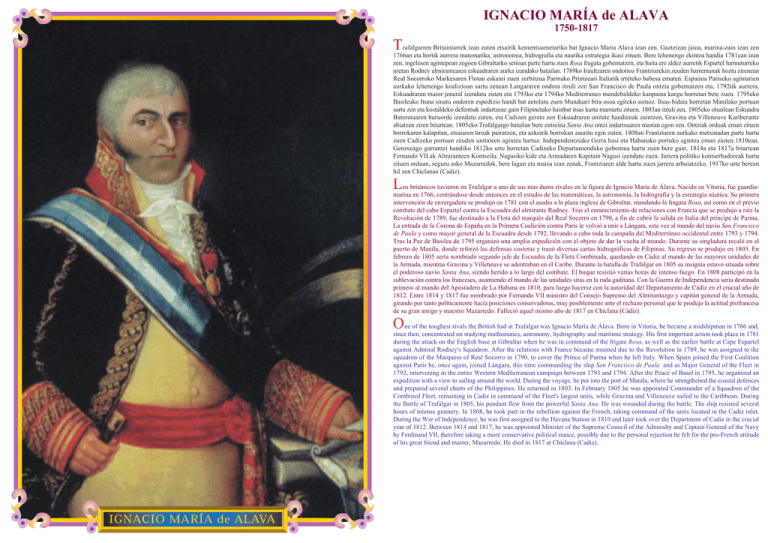
IGNACIO MARÍA de ALAVA 1750-1817 T rafalgarren Britainiarrek izan zuten etsairik kementsuenetariko bat Ignacio Maria Alava izan zen. Gazteizan jaioa, marina-zain izan zen 1766an eta hortik aurrera matematika, astronomia, hidrografia eta nautika estrategia ikasi zituen. Bere lehenengo ekintza handia 1781ean izan zen, ingelesen agintepean zegoen Gibraltarko setioan parte hartu zuen Rosa fragata gobernatzen, eta baita ere aldez aurretik Espartel lurmuturreko uretan Rodney almirantearen eskuadraren aurka izandako batailan. 1789ko Iraultzaren ondorioz Frantziarekin zeuden harremanak hoztu zirenean Real Socorroko Markesaren Flotan eskaini zuen zerbitzua Parmako Printzeari Italiatik irteteko babesa ematen. Espainia Pariseko agintarien aurkako lehenengo koalizioan sartu zenean Langararen ondora itzuli zen San Francisco de Paula ontzia gobernatzen eta, 1792tik aurrera, Eskuadraren maior jeneral izendatu zuten eta 1793ko eta 1794ko Mediterraneo mendebaldeko kanpaina kargu horretan bete zuen. 1795eko Basileako Ituna sinatu ondoren espedizio handi bat antolatu zuen Munduari bira osoa egiteko asmoz. Itsas-bidaia horretan Manilako portuan sartu zen eta kostaldeko defentsak indartzeaz gain Filipinetako hainbat itsas karta marraztu zituen. 1803an itzuli zen. 1805eko otsailean Eskuadra Bateratuaren buruorde izendatu zuten, eta Cadizen geratu zen Eskuadraren unitate handienak zaintzen, Gravina eta Villeneuve Kariberantz abiatzen ziren bitartean. 1805eko Trafalgargo batailan bere entseina Santa Ana ontzi indartsuaren mastan egon zen. Ontziak orduak eman zituen borrokaren kalapitan, etsaiaren tiroak pairatzen, eta azkenik borrokan zauritu egin zuten. 1808an Frantziaren aurkako matxinadan parte hartu zuen Cadizeko portuan zeuden unitateen agintea hartuz. Independentziako Gerra hasi eta Habanako portuko agintea eman zioten 1810ean. Geroxeago garrantzi handiko 1812ko urte horretan Cadizeko Departamenduko gobernua hartu zuen bere gain. 1814a eta 1817a bitartean Fernando VII.ak Almiranteen Kontseilu. Nagusiko kide eta Armadaren Kapitain Nagusi izendatu zuen. Jarrera politiko kontserbadoreak hartu zituen orduan, seguru asko Mazarredok, bere lagun eta maisu izan zenak, Frantziaren alde hartu zuen jarrera arbuiatzeko. 1917ko urte berean hil zen Chiclanan (Cadiz). L os británicos tuvieron en Trafalgar a uno de sus mas duros rivales en la figura de Ignacio María de Álava. Nacido en Vitoria, fue guardiamarina en 1766, centrándose desde entonces en el estudio de las matemáticas, la astronomía, la hidrografía y la estrategia náutica. Su primera intervención de envergadura se produjo en 1781 con el asedio a la plaza inglesa de Gibraltar, mandando la fragata Rosa, así como en el previo combate del cabo Espartel contra la Escuadra del almirante Rodney. Tras el enrarecimiento de relaciones con Francia que se produjo a raíz la Revolución de 1789, fue destinado a la Flota del marqués del Real Socorro en 1790, a fin de cubrir la salida en Italia del príncipe de Parma. La entrada de la Corona de España en la Primera Coalición contra París le volvió a unir a Lángara, esta vez al mando del navío San Francisco de Paula y como mayor general de la Escuadra desde 1792, llevando a cabo toda la campaña del Mediterráneo occidental entre 1793 y 1794. Tras la Paz de Basilea de 1795 organizó una amplia expedición con el objeto de dar la vuelta al mundo. Durante su singladura recaló en el puerto de Manila, donde reforzó las defensas costeras y trazó diversas cartas hidrográficas de Filipinas. Su regreso se produjo en 1803. En febrero de 1805 sería nombrado segundo jefe de Escuadra de la Flota Combinada, quedando en Cádiz al mando de las mayores unidades de la Armada, mientras Gravina y Villeneuve se adentraban en el Caribe. Durante la batalla de Trafalgar en 1805 su insignia estuvo situada sobre el poderoso navío Santa Ana, siendo herido a lo largo del combate. El buque resistió varias horas de intenso fuego. En 1808 participó en la sublevación contra los franceses, asumiendo el mando de las unidades sitas en la rada gaditana. Con la Guerra de Independencia sería destinado primero al mando del Apostadero de La Habana en 1810, para luego hacerse con la autoridad del Departamento de Cádiz en el crucial año de 1812. Entre 1814 y 1817 fue nombrado por Fernando VII ministro del Consejo Supremo del Almirantazgo y capitán general de la Armada, girando por tanto políticamente hacia posiciones conservadoras, muy posiblemente ante el rechazo personal que le produjo la actitud profrancesa de su gran amigo y maestro Mazarredo. Falleció aquel mismo año de 1817 en Chiclana (Cádiz). O ne of the toughest rivals the British had at Trafalgar was Ignacio María de Álava. Born in Vitoria, be became a midshipman in 1766 and, since then, concentrated on studying mathematics, astronomy, hydrography and maritime strategy. His first important action took place in 1781 during the attack on the English base at Gibraltar when he was in command of the frigate Rosa, as well as the earlier battle at Cape Espartel against Admiral Rodney's Squadron. After the relations with France became strained due to the Revolution in 1789, he was assigned to the squadron of the Marquess of Real Socorro in 1790, to cover the Prince of Parma when he left Italy. When Spain joined the First Coalition against Paris he, once again, joined Lángara, this time commanding the ship San Francisco de Paula and as Major General of the Fleet in 1792, intervening in the entire Western Mediterranean campaign between 1793 and 1794. After the Peace of Basel in 1795, he organised an expedition with a view to sailing around the world. During the voyage, he put into the port of Manila, where he strengthened the coastal defences and prepared several charts of the Philippines. He returned in 1803. In February 1805 he was appointed Commander of a Squadron of the Combined Fleet, remaining in Cadiz in command of the Fleet's largest units, while Gravina and Villeneuve sailed to the Caribbean. During the Battle of Trafalgar in 1805, his pendant flew from the powerful Santa Ana. He was wounded during the battle. The ship resisted several hours of intense gunnery. In 1808, he took part in the rebellion against the French, taking command of the units located in the Cadiz inlet. During the War of Independence, he was first assigned to the Havana Station in 1810 and later took over the Department of Cadiz in the crucial year of 1812. Between 1814 and 1817, he was appointed Minister of the Supreme Council of the Admiralty and Captain General of the Navy by Ferdinand VII, therefore taking a more conservative political stance, possibly due to the personal rejection he felt for the pro-French attitude of his great friend and master, Mazarredo. He died in 1817 at Chiclana (Cadiz).
